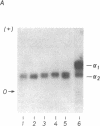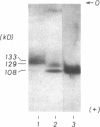Abstract
A MAb (TP-2) directed against human cholesteryl ester transfer protein (CETP) has been applied to the development of a competitive solid-phase RIA. Experiments with immobilized CETP have shown that upon incubation with plasma or HDL in the presence of Tween (0.05%) apo A-I (but not apo A-II) binds to CETP while TP-2 binding to CETP is concomitantly decreased. With high detergent concentration (0.5% Triton), the interference is eliminated and a specific RIA in which all plasma CETP fractions have the same affinity can be obtained. Plasma levels of CETP, apo A-I, lipids, and lipoproteins were measured in 50 normolipemic, healthy subjects of both sexes. CETP levels varied nearly fourfold with a mean value of 1.7 micrograms/ml. CETP was positively correlated only with apo A-I (r = 0.38) and HDL-triglyceride (r = 0.39). In 29 other normolipemic subjects, where several apolipoproteins were also measured, significant correlations of CETP with apo A-I (0.41), apo E (0.43), and HDL-cholesterol (0.41) were observed, but there was no significant relationship between CETP and either apo A-II, B, or D. In other experiments CETP was shown to be present mostly in HDL3 and VHDL, to display exclusively an alpha 2-electrophoretic migration, and to occur within discrete particles ranging in size from 129 to 154 kD. In conclusion, the association of CETP with apo A-I-containing lipoproteins probably explains the correlation between CETP and apo A-I levels. The relationship between CETP and apo E suggests either a common metabolism or a specific cooperative role in cholesterol ester transport for these proteins.
Full text
PDF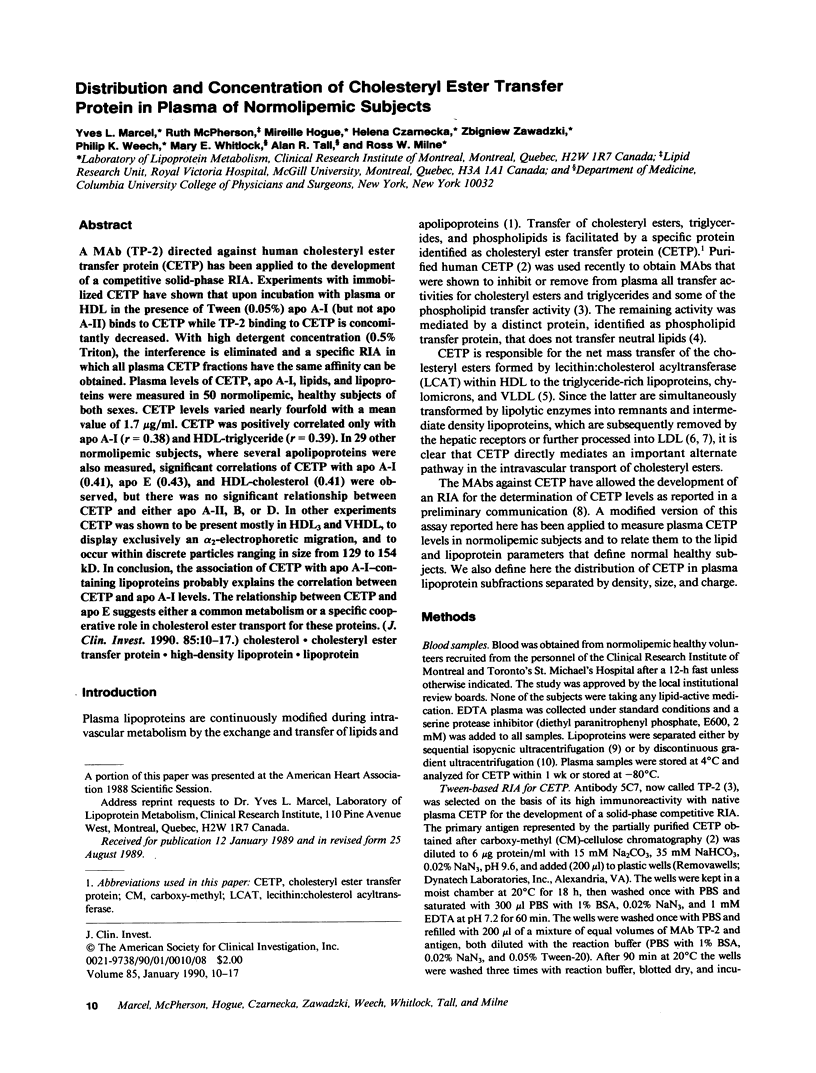
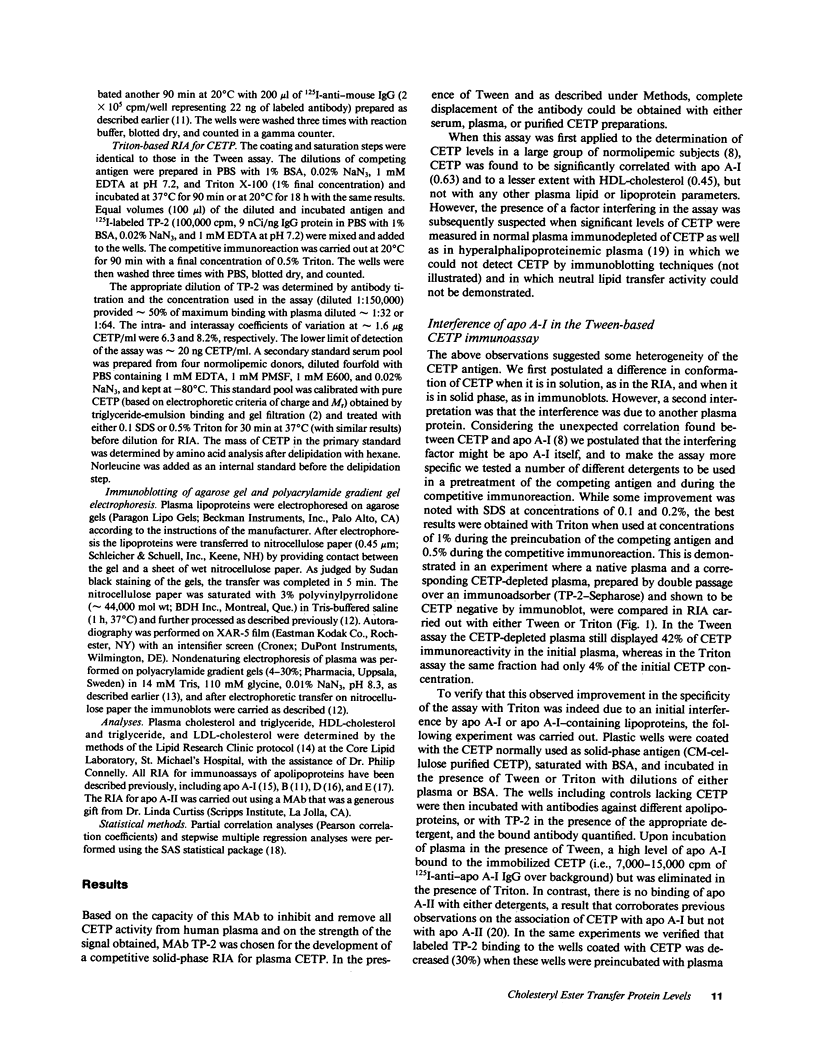
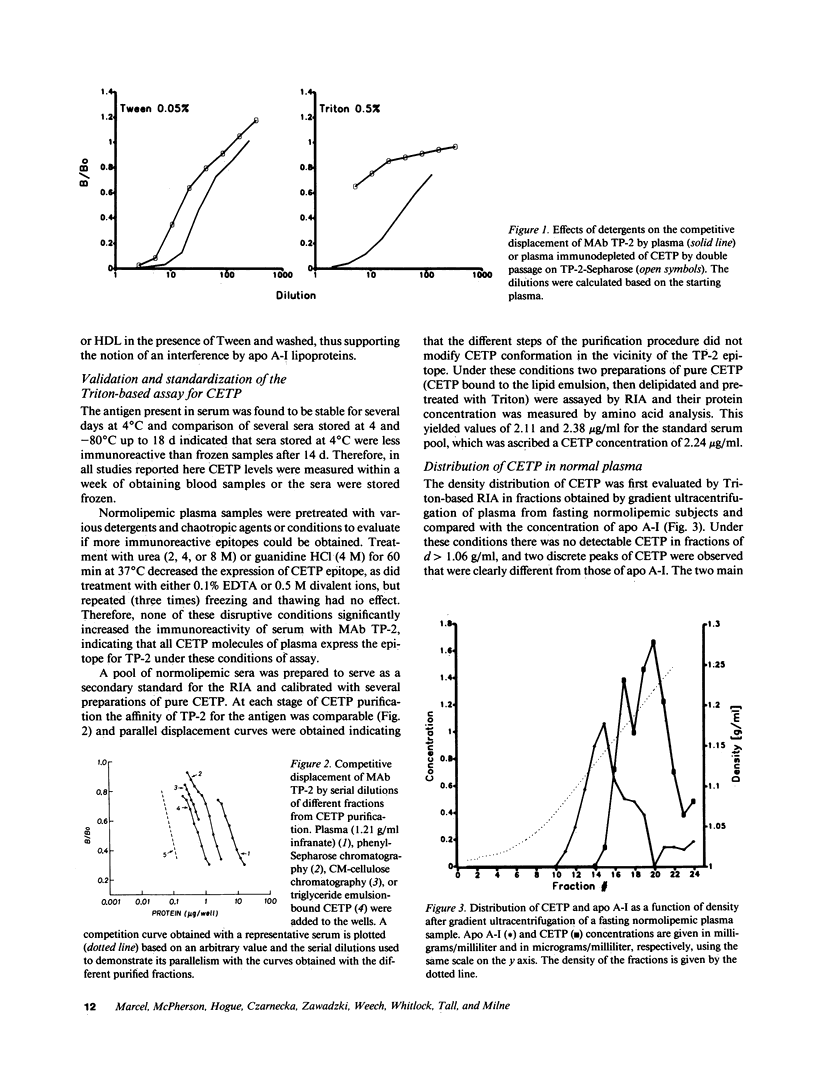
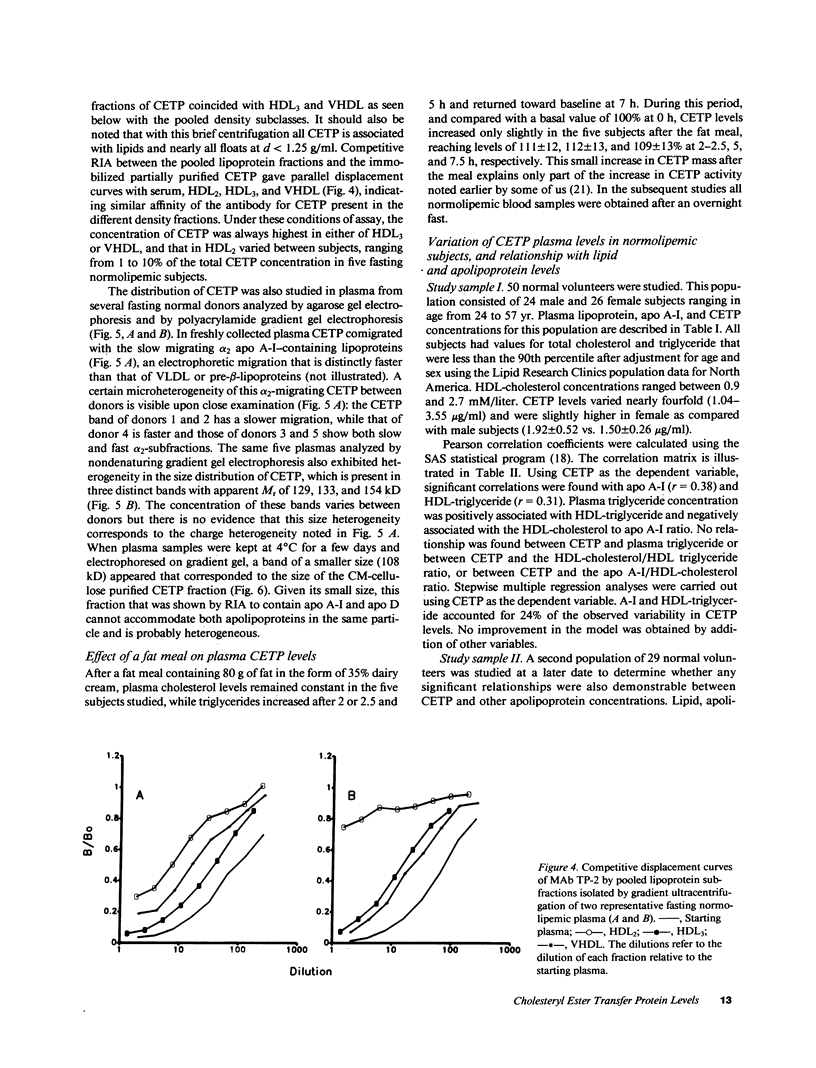
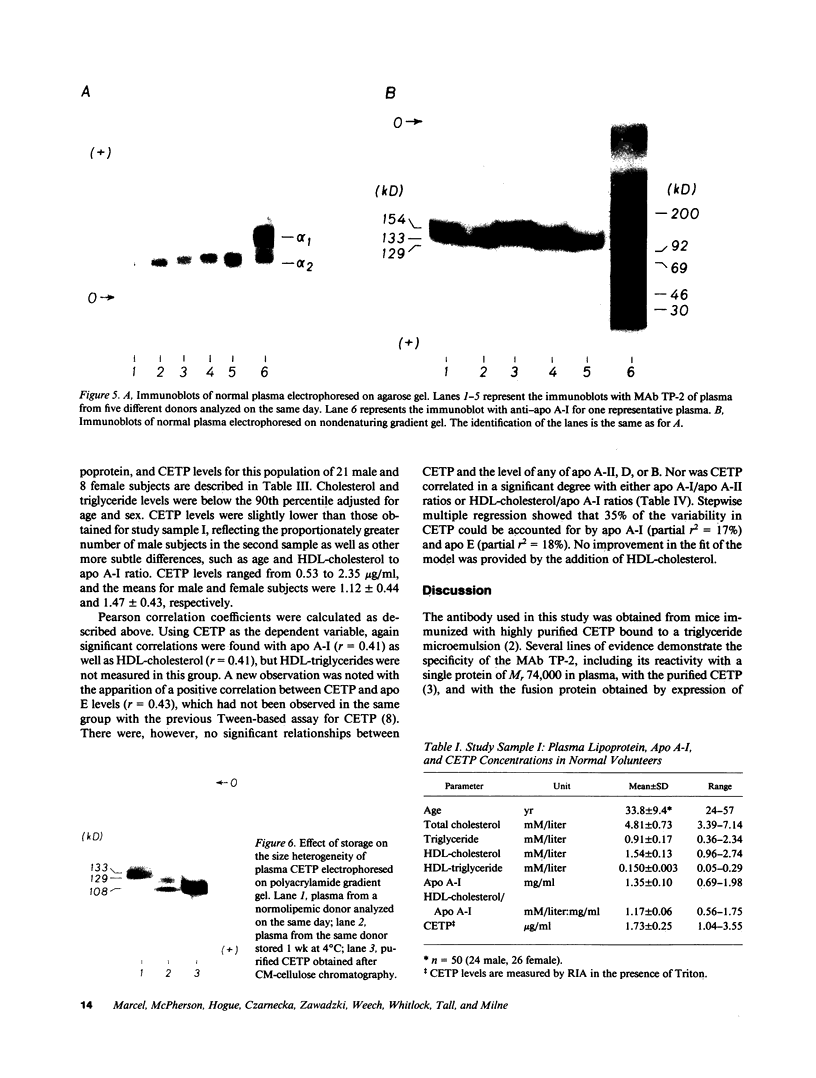
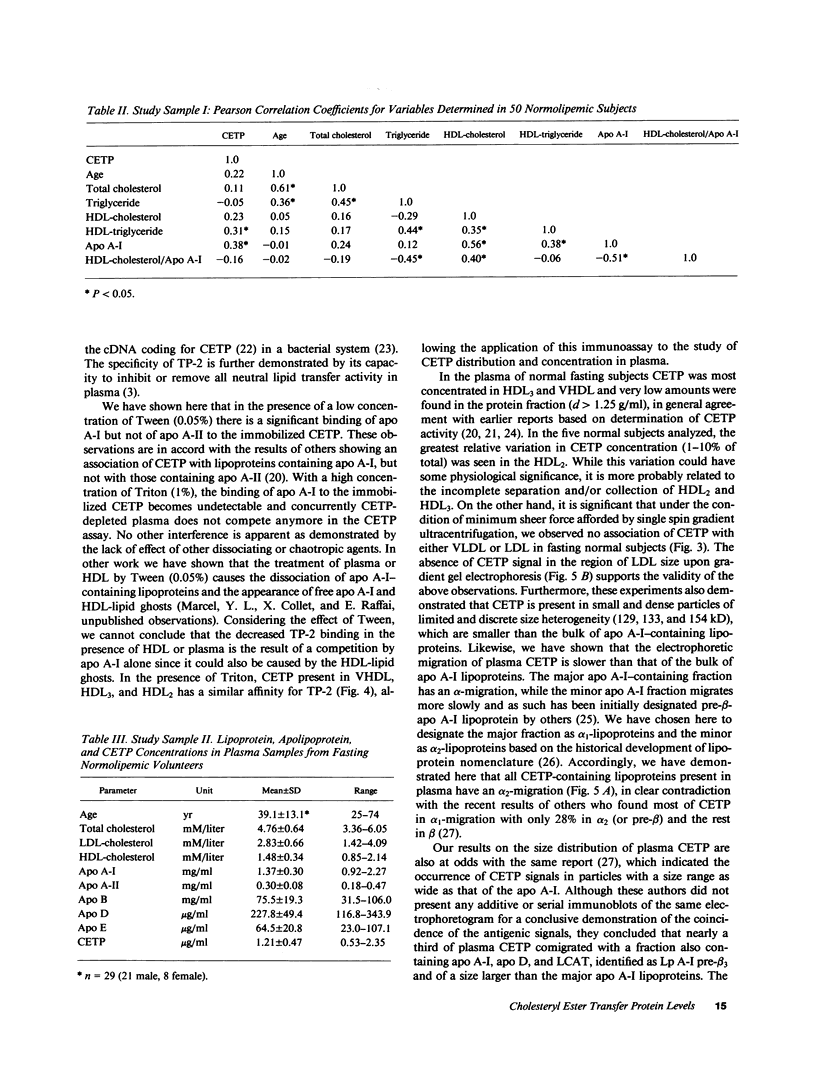
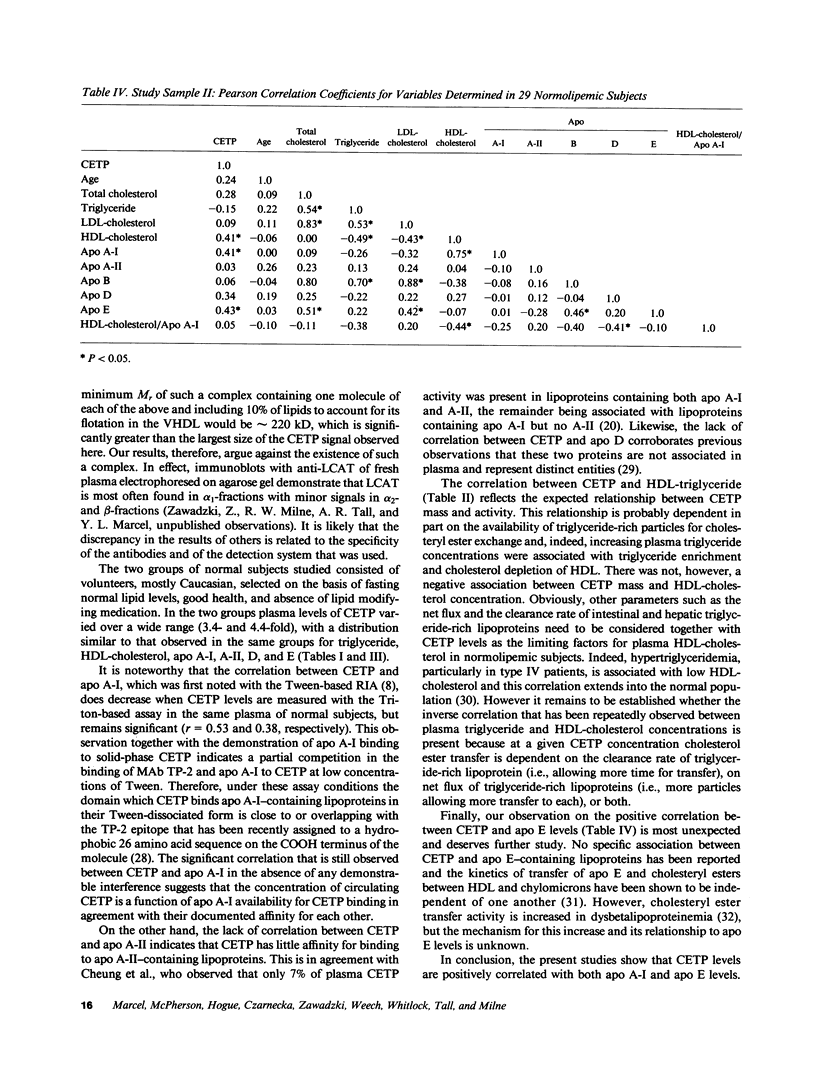
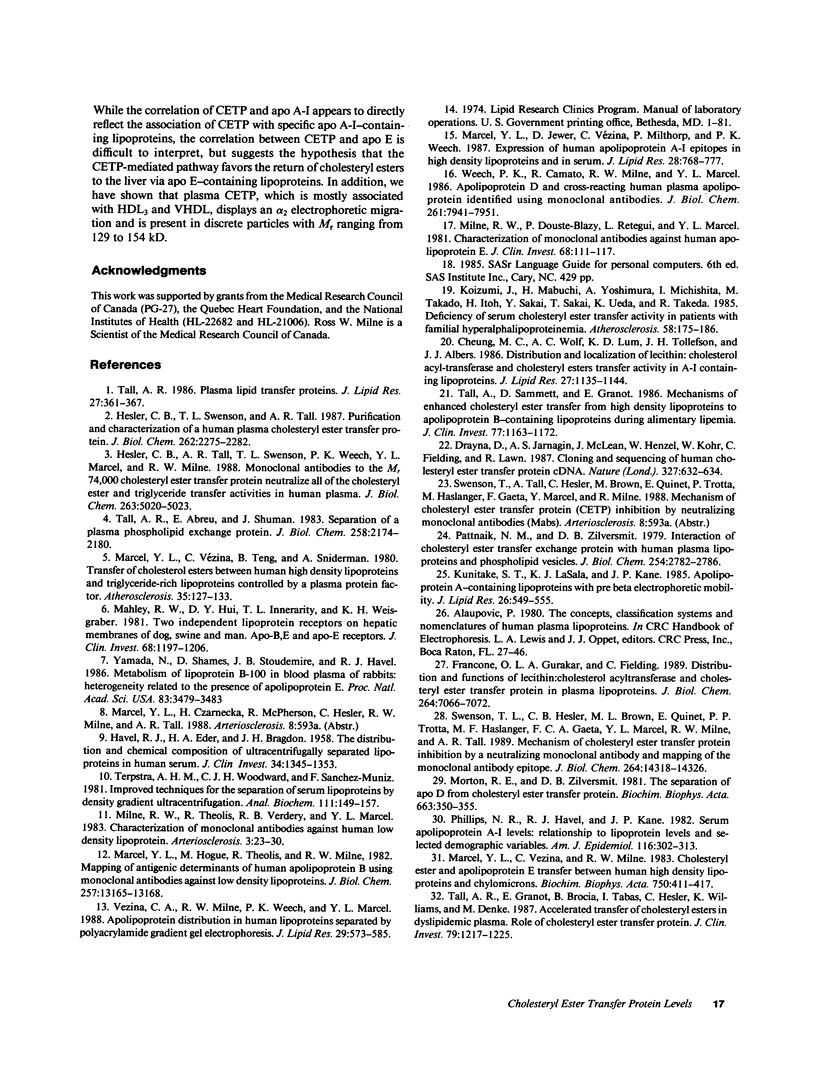
Images in this article
Selected References
These references are in PubMed. This may not be the complete list of references from this article.
- Cheung M. C., Wolf A. C., Lum K. D., Tollefson J. H., Albers J. J. Distribution and localization of lecithin:cholesterol acyltransferase and cholesteryl ester transfer activity in A-I-containing lipoproteins. J Lipid Res. 1986 Nov;27(11):1135–1144. [PubMed] [Google Scholar]
- Drayna D., Jarnagin A. S., McLean J., Henzel W., Kohr W., Fielding C., Lawn R. Cloning and sequencing of human cholesteryl ester transfer protein cDNA. Nature. 1987 Jun 18;327(6123):632–634. doi: 10.1038/327632a0. [DOI] [PubMed] [Google Scholar]
- Francone O. L., Gurakar A., Fielding C. Distribution and functions of lecithin:cholesterol acyltransferase and cholesteryl ester transfer protein in plasma lipoproteins. Evidence for a functional unit containing these activities together with apolipoproteins A-I and D that catalyzes the esterification and transfer of cell-derived cholesterol. J Biol Chem. 1989 Apr 25;264(12):7066–7072. [PubMed] [Google Scholar]
- HAVEL R. J., EDER H. A., BRAGDON J. H. The distribution and chemical composition of ultracentrifugally separated lipoproteins in human serum. J Clin Invest. 1955 Sep;34(9):1345–1353. doi: 10.1172/JCI103182. [DOI] [PMC free article] [PubMed] [Google Scholar]
- Hesler C. B., Swenson T. L., Tall A. R. Purification and characterization of a human plasma cholesteryl ester transfer protein. J Biol Chem. 1987 Feb 15;262(5):2275–2282. [PubMed] [Google Scholar]
- Hesler C. B., Tall A. R., Swenson T. L., Weech P. K., Marcel Y. L., Milne R. W. Monoclonal antibodies to the Mr 74,000 cholesteryl ester transfer protein neutralize all of the cholesteryl ester and triglyceride transfer activities in human plasma. J Biol Chem. 1988 Apr 15;263(11):5020–5023. [PubMed] [Google Scholar]
- Koizumi J., Mabuchi H., Yoshimura A., Michishita I., Takeda M., Itoh H., Sakai Y., Sakai T., Ueda K., Takeda R. Deficiency of serum cholesteryl-ester transfer activity in patients with familial hyperalphalipoproteinaemia. Atherosclerosis. 1985 Dec;58(1-3):175–186. doi: 10.1016/0021-9150(85)90064-4. [DOI] [PubMed] [Google Scholar]
- Kunitake S. T., La Sala K. J., Kane J. P. Apolipoprotein A-I-containing lipoproteins with pre-beta electrophoretic mobility. J Lipid Res. 1985 May;26(5):549–555. [PubMed] [Google Scholar]
- Mahley R. W., Hui D. Y., Innerarity T. L., Weisgraber K. H. Two independent lipoprotein receptors on hepatic membranes of dog, swine, and man. Apo-B,E and apo-E receptors. J Clin Invest. 1981 Nov;68(5):1197–1206. doi: 10.1172/JCI110365. [DOI] [PMC free article] [PubMed] [Google Scholar]
- Marcel Y. L., Hogue M., Theolis R., Jr, Milne R. W. Mapping of antigenic determinants of human apolipoprotein B using monoclonal antibodies against low density lipoproteins. J Biol Chem. 1982 Nov 25;257(22):13165–13168. [PubMed] [Google Scholar]
- Marcel Y. L., Jewer D., Vézina C., Milthorp P., Weech P. K. Expression of human apolipoprotein A-I epitopes in high density lipoproteins and in serum. J Lipid Res. 1987 Jul;28(7):768–777. [PubMed] [Google Scholar]
- Marcel Y. L., Vezina C., Milne R. W. Cholesteryl ester and apolipoprotein E transfer between human high density lipoproteins and chylomicrons. Biochim Biophys Acta. 1983 Feb 7;750(2):411–417. doi: 10.1016/0005-2760(83)90047-4. [DOI] [PubMed] [Google Scholar]
- Marcel Y. L., Vezina C., Teng B., Sniderman A. Transfer of cholesterol esters between human high density lipoproteins and triglyceride-rich lipoproteins controlled by a plasma protein factor. Atherosclerosis. 1980 Feb;35(2):127–133. doi: 10.1016/0021-9150(80)90078-7. [DOI] [PubMed] [Google Scholar]
- Milne R. W., Douste-Blazy P., Marcel Y. L., Retegui L. Characterization of monoclonal antibodies against human apolipoprotein E. J Clin Invest. 1981 Jul;68(1):111–117. doi: 10.1172/JCI110225. [DOI] [PMC free article] [PubMed] [Google Scholar]
- Milne R. W., Theolis R., Jr, Verdery R. B., Marcel Y. L. Characterization of monoclonal antibodies against human low density lipoprotein. Arteriosclerosis. 1983 Jan-Feb;3(1):23–30. doi: 10.1161/01.atv.3.1.23. [DOI] [PubMed] [Google Scholar]
- Morton R. E., Zilversmit D. B. The separation of apolipoprotein D from cholesteryl ester transfer protein. Biochim Biophys Acta. 1981 Jan 26;663(1):350–355. doi: 10.1016/0005-2760(81)90220-4. [DOI] [PubMed] [Google Scholar]
- Pattnaik N. M., Zilversmit D. B. Interaction of cholesteryl ester exchange protein with human plasma lipoproteins and phospholipid vesicles. J Biol Chem. 1979 Apr 25;254(8):2782–2786. [PubMed] [Google Scholar]
- Phillips N. R., Havel R. J., Kane J. P. Serum apolipoprotein A-I levels: relationship to lipoprotein lipid levels and selected demographic variables. Am J Epidemiol. 1982 Aug;116(2):302–313. doi: 10.1093/oxfordjournals.aje.a113414. [DOI] [PubMed] [Google Scholar]
- Swenson T. L., Hesler C. B., Brown M. L., Quinet E., Trotta P. P., Haslanger M. F., Gaeta F. C., Marcel Y. L., Milne R. W., Tall A. R. Mechanism of cholesteryl ester transfer protein inhibition by a neutralizing monoclonal antibody and mapping of the monoclonal antibody epitope. J Biol Chem. 1989 Aug 25;264(24):14318–14326. [PubMed] [Google Scholar]
- Tall A. R., Abreu E., Shuman J. Separation of a plasma phospholipid transfer protein from cholesterol ester/phospholipid exchange protein. J Biol Chem. 1983 Feb 25;258(4):2174–2180. [PubMed] [Google Scholar]
- Tall A. R. Plasma lipid transfer proteins. J Lipid Res. 1986 Apr;27(4):361–367. [PubMed] [Google Scholar]
- Tall A., Granot E., Brocia R., Tabas I., Hesler C., Williams K., Denke M. Accelerated transfer of cholesteryl esters in dyslipidemic plasma. Role of cholesteryl ester transfer protein. J Clin Invest. 1987 Apr;79(4):1217–1225. doi: 10.1172/JCI112940. [DOI] [PMC free article] [PubMed] [Google Scholar]
- Tall A., Sammett D., Granot E. Mechanisms of enhanced cholesteryl ester transfer from high density lipoproteins to apolipoprotein B-containing lipoproteins during alimentary lipemia. J Clin Invest. 1986 Apr;77(4):1163–1172. doi: 10.1172/JCI112417. [DOI] [PMC free article] [PubMed] [Google Scholar]
- Terpstra A. H., Woodward C. J., Sanchez-Muniz F. J. Improved techniques for the separation of serum lipoproteins by density gradient ultracentrifugation: visualization by prestaining and rapid separation of serum lipoproteins from small volumes of serum. Anal Biochem. 1981 Feb;111(1):149–157. doi: 10.1016/0003-2697(81)90243-8. [DOI] [PubMed] [Google Scholar]
- Vézina C. A., Milne R. W., Weech P. K., Marcel Y. L. Apolipoprotein distribution in human lipoproteins separated by polyacrylamide gradient gel electrophoresis. J Lipid Res. 1988 May;29(5):573–585. [PubMed] [Google Scholar]
- Weech P. K., Camato R., Milne R. W., Marcel Y. L. Apolipoprotein D and cross-reacting human plasma apolipoproteins identified using monoclonal antibodies. J Biol Chem. 1986 Jun 15;261(17):7941–7951. [PubMed] [Google Scholar]
- Yamada N., Shames D. M., Stoudemire J. B., Havel R. J. Metabolism of lipoproteins containing apolipoprotein B-100 in blood plasma of rabbits: heterogeneity related to the presence of apolipoprotein E. Proc Natl Acad Sci U S A. 1986 May;83(10):3479–3483. doi: 10.1073/pnas.83.10.3479. [DOI] [PMC free article] [PubMed] [Google Scholar]



